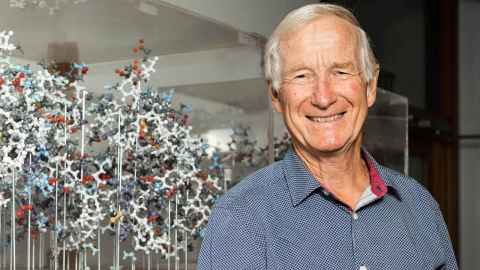Ted Baker looks back on his stellar scientific career
18 May 2023
Twenty years ago, Distinguished Emeritus Professor Ted Baker was on the cover of the first Ingenio. Donna Chisholm finds out about his career and his crystal-clear love of science.

Distinguished Emeritus Professor Ted Baker’s stellar scientific career is notable not only for his skills, but also a serendipitous sense of timing.
He began his PhD at the University of Auckland in the early 1960s. This was just after it installed its first computer, a behemoth of an IBM that took up much of a large room on the third floor of the Old Choral Hall and took the grunt work out of thousands of calculations his studies in X-ray crystallography would require.
Ted arrived at Oxford University for his post-doctoral fellowship in 1967, just as protein crystallography was taking off, and perfectly timed to be invited by Nobel Laureate Dorothy Hodgkin to join the team that was closing in on the structure of insulin.
By 1976, and with the help of equipment clandestinely purchased by his Massey University head of department, he had determined the structure of the kiwifruit enzyme actinidin, the first protein structure to be solved outside Europe and the United States.
In 1997, after 20 years at Massey, he moved to the University of Auckland as a professor of structural biology, arriving at the dawn of the genome-sequencing revolution and just before the launch of the Centres of Research Excellence.
Now, at 80 – five years into his retirement and 20 years after featuring on the cover of Ingenio’s first edition – Ted looks back with great pride at the evolution in the science that made his name – including startling developments in artificial intelligence and electron microscopy that his work has helped to bring about.
I think we’ll see an equilibrium between experimental science and predictive
science that will benefit both. Science always moves on, building on work that
has gone on before.

First, a brief primer on crystallography. Protein crystallisation is a painstaking and unpredictable process but the crystals are essential to obtain X-ray scattering patterns. From many thousands of scattered waves, laboriously measured, the structure of the molecules in the crystal can be imaged and interpreted. Hey presto! A three-dimensional atomic model, which for a protein will comprise thousands of atoms.
“I was good at maths, and enjoyed physics and chemistry. This was a combination of them all. It suited me.”
The family-oriented, collaborative environment at Oxford that Dorothy Hodgkin fostered had also suited him. As the insulin work there reached its climax, the lab was relocated into an old Victorian house where the small team of scientists included another New Zealander and alumnus, the late Professor Guy Dodson, and wife Eleanor. Ted’s wife Heather, an Auckland alumna and, like him, a chemistry graduate, was invited by Dorothy to join the team.
“Our newborn daughter, and two other young children, shared the room where we were doing the image interpretation and model building, so it was like a nursery. It was Dorothy’s holistic view of how science should be done.”
Ted returned home, enthused with the idea of bringing protein crystallography to New Zealand.
“I was greatly encouraged by Dorothy. When I told her of my wish, and also how few resources I would have, she said, ‘Oh, you shouldn’t worry about that, Ted, just get started and it will all fall into place in time.’”
And so it did. After proving the potential of his research in his time at Massey, on actinidin and other proteins, Ted received lucrative offers from overseas, but chose to move to the University of Auckland where he already had strong relationships. He became the first director of the Maurice Wilkins Centre for Molecular Biodiscovery, working with names such as Professor John Fraser, an expert on microbial biology and molecular immunology; Distinguished Professor Sir Bill Denny, renowned medicinal chemist and cancer drug researcher; Garth Cooper, a professor of biological sciences and expert in diabetes, drug discovery, and protein and peptide chemistry; and Distinguished Professor Peter Hunter, whose 3D mathematical models of cells and organs increased understanding of physiology.
Ted’s work increasingly focused on bacteria, specifically streptococcus and the tuberculosis bacterium. “The first genomes sequenced were bacterial, so Mycobacterium tuberculosis was an obvious target because it was such a serious health problem around the world.”
Our newborn daughter, and two other young children, shared the room where we were doing the image interpretation and model building, so it was like a nursery.
His research, supported by the Health Research Council, saw his lab invited to join a US National Institutes of Health-sponsored international consortium including labs from the UK, Germany, India and Korea. The research has vastly increased scientists’ understanding of the TB bacterium, and other bacteria. It led indirectly to the development of new therapies for tuberculosis, including three from Bill Denny’s lab that have reached clinical trials.
Since Ted’s 2003 Ingenio cover appearance, there have been many achievements and accolades.
The protein structures he and his group determined enabled them to define mechanisms by which bacteria cause disease. These included, in 2015, a previously unknown protein Rv1738 that enables the TB organism to hibernate in the lungs and evade the immune system. In 2016, there was another protein, MenD, found to be essential for making vitamin K and an important target for anti-TB drug design.
In 2006, Ted was awarded the Rutherford Medal and in 2007 became a Companion of the NZ Order of Merit for services to science.
He says during his latter years at the University, he took greatest pride in helping promising young scientists in his lab to develop their own ideas and careers. These included former Korean PhD student Hae Joo Kang, whose work on a mystery protein from streptococcus helped identify it as a key vaccine target, and Jodie Johnston, now at the University of Canterbury, researching microbial pathogens and antibiotic resistance.
Another student star was Iranian-born Dr Ghader Bashiri, now a senior lecturer in the School of Biological Sciences. Ghader’s work focuses not just on tuberculosis, but also the development of possible compounds to reduce methane emissions.
Ted is happy to see these new directions emerging for the future, not only of science, but the planet.
And as for crystallography itself? The huge amount of information about protein structure, almost all from crystallography, is freely accessible from the Worldwide Protein Data Bank. There, it enables structure-based drug design and other applications – most recently artificial intelligence – to enter the field. With massive computing power now available, scientists have applied AI to the task of predicting the structure of any protein from its amino acid sequence, informed by the database of known structures.
It is too early to say what the full impact will be, Ted says.
“I think we’ll see an equilibrium between experimental science and predictive science that will benefit both. Science always moves on, building on work that has gone on before.”
He’s proud that his research in crystallography has helped make that momentum possible. And would he choose a different branch of science as a doctoral student today?
“I’d always choose experimental science. When you see something for the first time – a new protein structure, for example – and dig deeply into it, there is such a feeling of excitement. I have loved every minute of my time in research.”
MAURICE WILKINS CENTRE
The Maurice Wilkins Centre for Molecular Biodiscovery is a Centre of Research Excellence, one of ten funded by the government until 2028. Its director is Professor Greg Cook from the University of Otago and its deputy directors, from the University of Auckland, are Professor Dame Margaret Brimble and Professor Peter Shepherd. The centre was named after New Zealand-born physicist Maurice Wilkins, who won the 1962 Nobel Prize for Medicine with Francis Crick and James Watson.
This story first appeared in the Autumn 2023 edition of Ingenio.